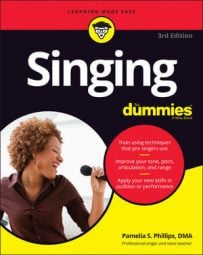Nasal resonance is different from a nasal sound even though both involve moving air through your nose. Nasal resonance involves taking advantage of the sound resonating in the nasal passages. If all the sound resonates in your nasal passages, the sound is a nasal sound or too nasal.
Air shouldn’t be moving out of your nose unless you’re humming or for the split second it takes for you to make a nasal consonant (M, N, NG). To help you feel the sounds of nasal resonance and feel the air moving out of your nose, try the following exercise:
Hum a few bars of a song to feel buzzing around your lips.
Humming is prolonging an M consonant. You should be able to feel the buzzing or resonance of that consonant in your nasal passages.
Try humming while holding your nose.
Doesn’t work, does it? When you close your mouth and hold your nose, the air has no escape route.
Hum again without holding your nose.
Notice the flow of the air coming out of your nose. This escape route is just fine when you’re singing, as long as you allow the air to escape only when you’re pronouncing nasal consonants, such as M, N, or NG. When the soft palate lifts again, the air escapes out of your mouth, creating a more balanced resonant tone.
When you open your mouth for a vowel, you want the air to come out of your mouth. If it doesn’t, the sound is nasal. Remember that you can have air coming out of your nose as you’re singing nasal consonants, but not while you’re singing a vowel sound.
If air comes out of your nose while you’re singing a vowel, you create an undesirable nasal sound, which doesn’t take advantage of all the resonators.

